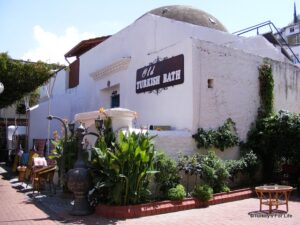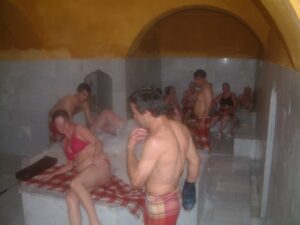What is Turkish Bath?
 The meaning of Hammam (known as Turkish Bath) is of Arabic origin and means heating and being warm. Since ancient times, most communities have Hammam in different forms.
The meaning of Hammam (known as Turkish Bath) is of Arabic origin and means heating and being warm. Since ancient times, most communities have Hammam in different forms.
Turks, especially the Ottomans gave importance to the baths due to the importance given to cleaning and Hamam culture has come to the present day.
During the Ottoman period, many public baths were built. Apart from these, small baths were built in old houses, mansions and near the waterside mansions.
But today, when the ‘What is Turkish Bath?’ question is asked, the answer is that they are the small places giving bath and traditional massage services. In Turkey, hotels and most spa centers includes a small Hammam section.
Traditional and Ancient Turkish Bath
 In response to the question of ‘What is Hammam or Turkish Bath’, the best explanation is given by telling the history of the bath. Hamam culture is based on the Roman Empire, but it is a tradition associated with Turkish culture.
In response to the question of ‘What is Hammam or Turkish Bath’, the best explanation is given by telling the history of the bath. Hamam culture is based on the Roman Empire, but it is a tradition associated with Turkish culture.
Traditional Turkish Hammam is called as the place which helps muscles to relax, body to rest, spiritual and physical dirt can be purification. In the early period of the Ottoman people, cleaning was an important and vital necessity, so they usually went to the baths as there were no bathing facilities in their homes. Going to a hammam is a very common and traditional activity. Especially women, once a week, went to the hammam together, they were cleaned there and together they would eat and have fun.
Traditional Turkish Bath, unlike home baths, is constantly hot and humidity is quite high. This warm environment allows the muscles of the body to relax and rests the body. In the hammam hot and steam effect helps skin to get rid of dead skin and facilitates the opening of pores. Turkish baths have taken their place among the secrets of beauty of Ottoman women.
In the Turkish Bath, people could comfortably relax, bath, and warm their bodies. Since it was not often possible to go to the baths in old times, the pouch was made by bath attendant or masseur when it was going. These masseurs are called as ‘tellak’ in Turkish. This tradition has come the same way to to the present day. Still masseurs called as tellak are found in the Hammam and they provide traditional massage services. The names of the masseurs are different for women and men.
Structure of Hammam
 Turkish Hammam is differ from other baths in several ways. The most important role in this difference is the internal structural changes. Turkish baths generally consists of three parts as dressing, washing and heating. The dressing section is where visitors changing clothes before and after the bath.
Turkish Hammam is differ from other baths in several ways. The most important role in this difference is the internal structural changes. Turkish baths generally consists of three parts as dressing, washing and heating. The dressing section is where visitors changing clothes before and after the bath.
Today, dressing sections are made as cabins or rooms. Washing section is the main section of the Hammam, where visitors clean, bath and rest. The washing section actually consists of three parts. Kurna; the place of hot and cold water taps and where people wash, Halvet; the closed area where people use and wash alone and Göbektaşı is a humid steam chamber, the central, raised platform above the heating source. Heating section is located under the Hammam and the heater welding works continuously. This heater is used to heat both the water and the bath.
